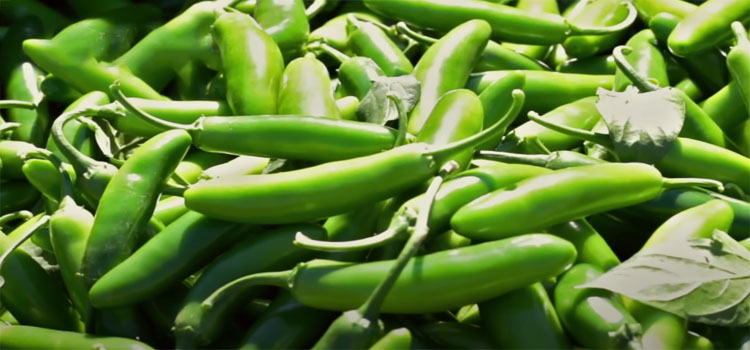Last Updated on July 17, 2024 by Shari Mason
The flavors of Indian cuisine are famous for their enticing and robust tastes, with peppers being key to providing its trademark heat.
As someone who appreciates the culinary wonders of India, I’ve often wondered about the peppers used in Indian food.
Let’s look at the vibrant world of peppers in Indian cuisine and discover the delightful flavors they bring to the table.
5 Common Peppers Used In Indian Cooking


- Kashmiri Chili: Known for its vibrant red color, the Kashmiri chili [1] adds mild to medium heat to dishes. It also imparts a beautiful red hue, making it a popular choice for color and flavor in curries, tandoori marinades, and spice blends.
- Green Chili: Green chilies are widely used in Indian cuisine and vary in their level of spiciness. They bring fresh and bright heat to dishes, adding a flavorful kick to curries, chutneys, and street food.
- Bird’s Eye Chili: Also known as “Thai chili” or “Indian chili,” the small and fiery bird’s eye chili packs a punch of heat. It is used sparingly to add intense spiciness to dishes, such as hot sauces, pickles, and spicy curries.
- Cayenne Pepper: Cayenne pepper, derived from dried red chili peppers, is ground into a fine powder. It offers moderate heat and is a common ingredient in spice blends like garam masala and marinades, sauces, and meat dishes.
- Red Chili Powder: This powdered form of dried red chilies provides a vibrant red color and considerable heat. It is used in various curries, marinades, and spice mixtures to add flavor and spiciness.
“To grow a tomato or a pepper and prepare a meal from your labor and care is primordially satisfying.’
– Nell Newman, American Actress
How Do Peppers Enhance The Flavor Of Indian Dishes?
- Robustness and Depth: Peppers add a robust and earthy undertone to dishes, creating a foundation of flavor that complements other spices and ingredients.
- Pungency and Heat: The spiciness of peppers awakens the taste buds, providing a lively and stimulating element to Indian cuisine.
- Aromatic Complexity: Peppers [2] release enticing scents as heated, infusing dishes with a captivating aroma that enhances the overall sensory experience.
- Flavor Layering: Peppers interact with other spices, herbs, and ingredients, contributing to the harmonious layering of flavors in Indian dishes.
- Distinctive Essence: The combination of flavors brought by peppers adds a unique and unmistakable essence to Indian cuisine, making it distinct and unforgettable.
Read: Guide To Making Garlic Naan with Store-Bought Naan
Are All Indian Peppers Extremely Spicy?


While Indian cuisine is renowned for its spiciness, not all Indian peppers are incredibly spicy. The level of spiciness can vary among different types of peppers used in Indian cooking.
For example, although commonly used, green chilies can range from mild to moderately spicy, offering options for those who prefer a more moderate heat level.
“From the fiery reds to the gentle greens, these peppers are the enchanting notes that compose the symphony of Indian spice, infusing each bite with warmth and a burst of aromatic bliss.”
– Eat Pallet Restaurant & Food Advice
It’s important to note that the perception of spiciness can also be subjective and vary from person to person.
However, there are certainly peppers, such as the bird’s eye chili, known for their intense heat and spiciness.
It’s always advisable to exercise caution and adjust the quantity of peppers according to personal taste preferences when cooking Indian dishes.
But what does butter chicken taste like?
Can Peppers Be Substituted In Indian Recipes?
Yes, peppers can be substituted in Indian recipes to suit personal preferences and availability. If you prefer a milder level of spiciness, you can reduce the amount of peppers used or choose milder varieties.
For example, you can replace a spicier pepper with a milder one, such as substituting a bird’s eye chili with a milder green chili.
It’s important to note that while the heat level may change, the substitution may also impact the overall flavor profile of the dish.
Experimenting with different pepper substitutes allows for customization, ensuring the desired spiciness and flavor in your Indian recipes. Also, what are the best potatoes for curry?
FAQs
u003cstrongu003eWhich pepper is famous in India?u003c/strongu003e
One pepper that is famous in India is the Kashmiri chili. It is known for its vibrant red color and moderate spiciness. u003cbru003eu003cbru003eThe Kashmiri chili is widely used in Indian cuisine to add heat and a beautiful red hue to dishes such as curries, tandoori marinades, and spice blends. Find out u003ca href=u0022https://eatpallet.com/how-long-can-indian-food-last-in-the-fridge/u0022u003ehow long Indian food will last in the fridge hereu003c/au003e.
u003cstrongu003eWhat pepper is used in curry?u003c/strongu003e
The pepper commonly used in curry is the red chili pepper. This pepper adds both heat and flavor to curry dishes. u003cbru003eu003cbru003eIt is typically used in dried and ground form, known as red chili powder. But do you know u003ca href=u0022https://eatpallet.com/how-long-does-curry-last-in-the-fridge/u0022u003ehow long will curry last in the fridgeu003c/au003e?
In Conclusion
Peppers play a significant role in the flavor profile of Indian food, adding heat, depth, and complexity to dishes.
Each pepper has unique characteristics, contributing to the spiciness, aroma, and overall taste experience.
Whether it’s the mild warmth of green chilies or the fiery kick of cayenne pepper, these peppers infuse Indian food with their unmistakable essence.
Their careful selection and use by skilled cooks result in the captivating flavors that make Indian cuisine so beloved and enticing.
References:
- https://csef.usc.edu/History/2015/Projects/S1508.pdf
- https://www.epicurious.com/ingredients/20-types-of-peppers-and-their-uses-article
- How to Cancel a Pizza Hut Order? Quick & Easy Guide - July 26, 2024
- How Long Do I Cook a DiGiorno Pizza? Perfect Timing Tips - July 26, 2024
- What Kind of Advertising Do Restaurants Use? - July 24, 2024

